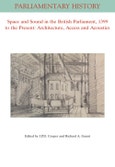- Experts in parliamentary history, political science, architecture and acoustics assess the influence of the pre- and post-1834 Palace of Westminster on the debate, procedure, ceremonial and identity of the two Houses of Parliament
- Running themes include the layout and acoustics of the Commons chamber, women’s access to politics, the Palace of Westminster as national icon and symbol of democracy, and the challenges of maintaining a historic building as the modern national legislature
- This volume draws on the research of the ‘St Stephen’s Chapel Westminster’ and ‘Listening to the Commons’ projects funded by the Arts and Humanities Research Council at the University of York, in partnership with the UK Parliament.
Table of Contents
1. Architecture and Politics in the Palace of Westminster, 1399 to the Present (J.P.D. Cooper and Richard A. Gaunt)
2. The Painted Chamber at Westminster and the Openings of Parliament, 1399 - 1484 (Jennifer Caddick)
3. The Elizabethan House of Commons and St Stephen’s Chapel Westminster (J.P.D. Cooper)
4. The Sound of Debate in Georgian England: Auralizing the House of Commons (Catriona Cooper)
5. Ventilating the Commons, Heating the Lords, 1701-1834 (Elizabeth Hallam-Smith)
6. A sense of crowd and urgency’? Atmosphere and inconvenience in the chamber of the old House of Commons (Paul Seaward)
7. Parliament as viewed through a woman’s eyes: gender and space in the nineteenth-century Commons (Sarah Richardson)
8. St Stephen’s in war and peace: civil defence and the location of Parliament, 1938-51 (Miles Taylor)
9. The Palace of Westminster: Another Window of Opportunity? (Leanne-Marie Cotter)
Index








